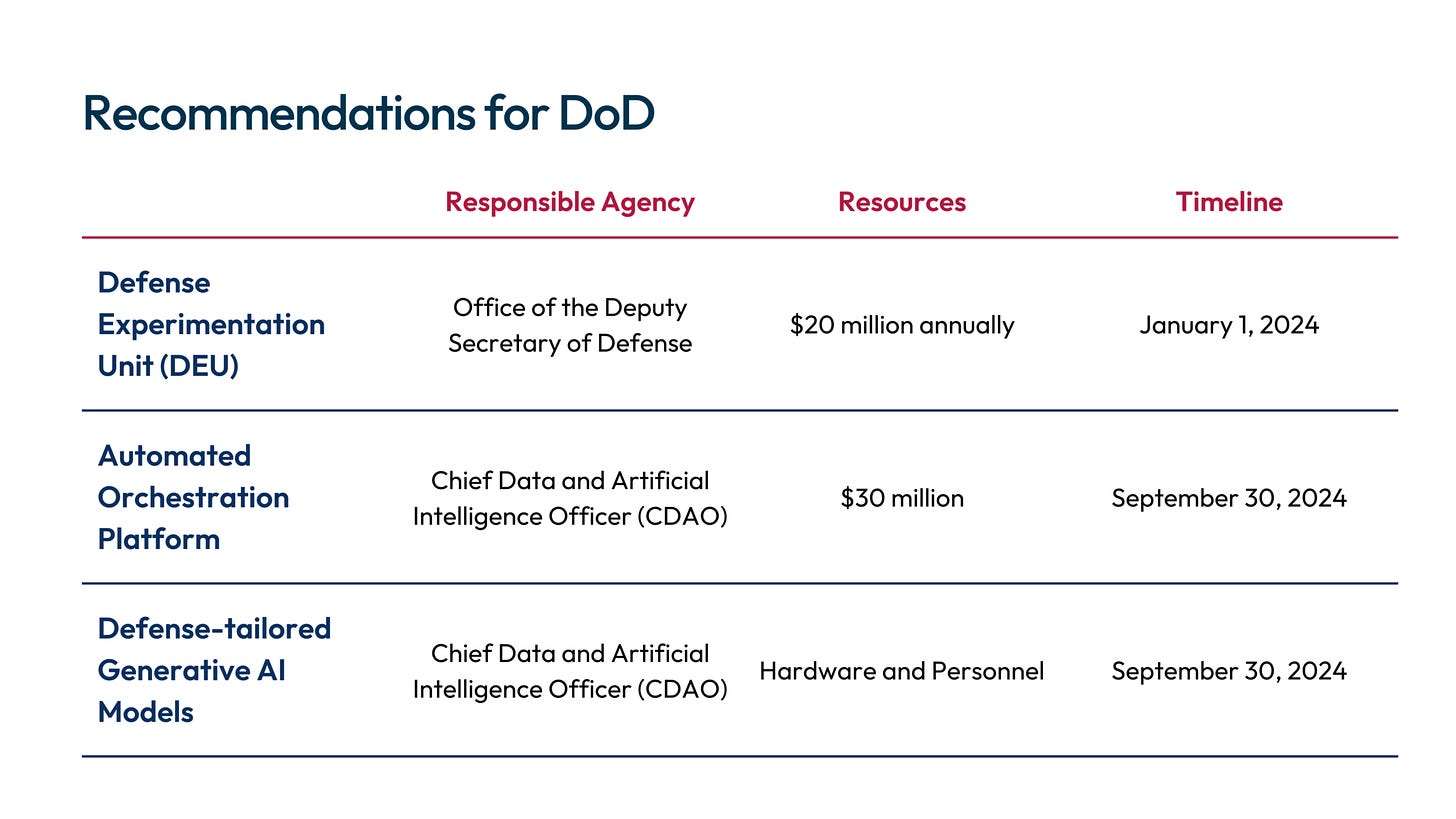Department of Defense Adoption of Generative Artificial Intelligence: A Summary
Hello, I’m Ylli Bajraktari, CEO of the Special Competitive Studies Project. In this edition of 2-2-2, SCSP’s Luke Vannurden and Tyler Vail provide an overview of the Defense memo of SCSP’s recent report, Generative AI: The Future of Innovation Power. The link to the full memo on Department of Defense Adoption of Generative Artificial Intelligence can be found here.
Generative AI: The Future of Innovation Power Featured on SCSP’s NatSec Tech
Members of the SCSP team join Jeanne Meserve to summarize each memo from our fall report, “Generative AI: The Future of Innovation Power.”
In this fifth episode, SCSP’s Justin Lynch and Luke Vannurden summarize the memo on Department of Defense Adoption of Generative Artificial Intelligence.
We find ourselves in the midst of another technological revolution. As in revolutions past, future innovations will impact nearly every facet of our lives, to include the ways in which we wage war and promote and defend our interests. However, unlike some of the past revolutions, the one that has been initiated by generative AI (GenAI) is unfolding so rapidly that it risks outpacing our ability to take full advantage of the moment.
Department of Defense Adoption of Generative Artificial Intelligence
While the full extent and the precise destination of this technological revolution may presently be unknown, the United States has opened a clear advantage in GenAI. It has an enormous opportunity to leverage its potential to prepare for the future character of conflict and ensure its military overmatch, particularly against the People’s Republic of China (PRC). The Department of Defense (DoD) appears to recognize the importance of this moment, and has established Task Force Lima – an effort that aims to analyze and integrate GenAI tools across the Pentagon.
To help DoD succeed in this effort, we have suggested prioritizing four critical areas. The first area is GenAI’s potential to enable decision advantage. Among the current opportunities enabled by GenAI, the most encouraging is its potential to support decision makers as a cognitive co-pilot. GenAI, when securely integrated with various defense platforms and operation centers, could help improve the intake and analysis of information, and enable faster decision making.
The second priority area we have spotlighted pertains to GenAI’s potential to enhance current defense operations. DoD is already exploring uses of AI for certain predictive maintenance and back-office support functions. As GenAI has and continues to improve, it has the potential to streamline logistics and sustainment planning and execution, inform investment and divestment decisions, facilitate experimental course of action generation, and enable global force deployment management decisions.
The third area that DoD should prioritize is the development of technical talent. GenAI will most certainly cause disruptions in labor markets and impact labor productivity in both the private and public sectors. The preponderance of military occupations will not be immune to these changes. Therefore, DoD should proactively address this by analyzing which occupational specialty series will be impacted the most, which new ones may need to be established, and what additional talent needs to be recruited, developed, and retained in order to meet evolving mission requirements associated with GenAI.
Finally, we have suggested DoD prioritize identifying new defense requirements against GenAI-enabled threats. GenAI is available both to us and our adversaries. DoD should evaluate which threats, ranging from misinformation to cyber attacks to chemical and biological weapons, can be reasonably expected to arise and grow in complexity, and identify necessary defensive measures to combat and deter them.
Concrete Steps
While the evolving character of conflict and China's ambitions pose serious concerns, the Department of Defense has a tremendous opportunity: nearly all the companies that have created frontier GenAI models are American. Our national innovation power, particularly our private sector ecosystem of innovation, is hard, if not impossible, to replicate by other nations. SCSP has previously offered a competitive defense strategy - Offset-X - that would translate the potential of our nation’s innovation power into hardened defenses and military advantages. With GenAI now here, it is important to urgently position the DoD to both capitalize on today’s advances and prepare for increasingly powerful and sophisticated models, including potentially artificial general intelligence and superintelligence.
In order to enable progress in the four areas we outlined here, the Department of Defense should also urgently pursue three concrete steps:
Establish a Defense Experimentation Unit (DEU). DEU could complement extant groups like the Defense Innovation Unit (DIU) or the Chief Digital and AI Office (CDAO), providing critical operational experimentation with various AI models to enable the mainstreaming of GenAI.
Build an Automated Orchestration Platform. This platform would serve as an intermediary between users and the vast suites of tools and databases available in many military environments. The GenAI-enabled interface could receive user prompts, deconstruct queries into discrete tasks, and semi-autonomously (or autonomously) complete them.
Develop Defense Tailored GenAI models. These models would be trained on well-defined military terms and jargon, secured from revealing datasets, tuning, or the contents of their prompts and their outputs, be inspectable and instrumented by cleared researchers, and accessible to cleared personnel for operational purposes.
Embracing generative AI, and other AI-enabled tools has the potential to enhance decision-making, streamline operations, augment our talent, and fortify national defense. It is imperative that the United States harness this cutting-edge technology to ensure its military overmatch relative to its adversaries, but also safeguard its position in an increasingly competitive and technologically driven global landscape.









